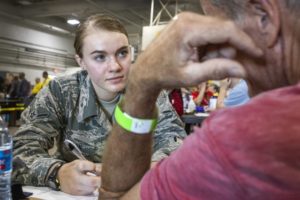
U.S. Air Force Airman Hannah E. Uron, Aerospace Medical Technician, 177th Fighter Wing, New Jersey Air National Guard, performs a health assessment on a homeless veteran during the Sgt. 1st Class Robert H. Yancey Sr. Stand Down at the National Guard Armory in Cherry Hill, NJ, in 2019. New Jersey National Guard Soldiers and Airmen cooked meals and provided medical assistance at the Stand Down where 187 homeless veterans. Photo by Mark Olsen.
BIRMINGHAM, AL — From 2010 to 2016, the number of veterans living on the streets dropped by half and the ending veteran homelessness within a decade appeared feasible. Then, progress stopped. In 2018, 2019, and 2020, the number of homeless veterans hovered at just over 37,000, year after year.
In a joint statement, the heads of the two agencies most directly involved in housing veterans, the VA and the Department of Housing and Urban Development, recommitted to the effort. “We, the secretaries of VA and HUD, are aligning efforts and joining forces to work towards ending veteran homelessness. We are mobilizing the strength of our two departments to do everything in our power to ensure every veteran has access to safe and stable housing,” said HUD Secretary Marcia Fudge and VA Secretary Denis McDonough.
The timing couldn’t be tougher. The current number of homeless veterans remains a bit of a mystery because the 2021 census couldn’t be completed because of restrictions in place to control the spread of COVID-19. But no one thinks fewer veterans need housing. The secretaries noted that “this number does not account for the impact of the COVID-19 pandemic, which has added to the nation’s housing challenges, including among veterans.”
The virus not only made counting the homeless challenging; it made staying housed harder as well. With many jobs vanishing in 2020 as people stayed home and habits changed to avoid exposure to the coronavirus, more veterans and many other Americans lost jobs and had difficulty paying rent and mortgages.
A federal moratorium on evictions slowed the number turned out of their homes in the last year, but that may simply result in a larger number of people suddenly simultaneously seeking new housing. A Supreme Court decision in late August struck down the national Centers for Disease Control and Prevention’s moratorium, freeing landlords to pursue evictions. At the same time, renters face sharply increased housing prices in many markets as a result of a shortage of both homes to purchase and apartments to rent. According to the real estate website Apartment List, rental prices rose 9.2% from January to June 2021, three to four times the typical rate of increase.
The rising prices and limited stock of housing options may make the VA’s and HUD’s Housing First approach difficult to translate into more veterans housed. Vouchers simply can’t secure apartments that don’t exist.
“A significant obstacle to ending veteran homelessness is the lack of affordable housing, especially in many urban centers,” the secretaries candidly observed. Pledging to work to increase both supply and access, they said, “our agencies will do this by engaging landlords, and affordable housing developers, supporting the use of federal programs to create and subsidize affordable housing, identifying ways to improve veteran access to these housing units, and supporting state and local collaboration to finance and create affordable housing.”
Increased Risk
While veterans are only slightly more likely to experience homelessness than the average person in the U.S., 21 per 10,000 vs. 17 per 10,000, they do have some notable risk factors. A study published this month in the American Journal of Preventive Medicine by VA researchers led by Stefan Kertesz, MD, of the Birmingham VA Health Care System and the School of Medicine at the University of Alabama at Birmingham, found some distinctive characteristics among veterans who experience homelessness.1
In a national sample of 5,406 veterans, those who reported they had more than seven nights without shelter in the previous six months (8.9%) were more likely to be unmarried, have interacted with the criminal justice system, lack social support, have health conditions and substance use issues, and generate too little income to meet basic needs.
Homeless veterans were also more likely to live in communities that had fewer beds available in shelters and warmer temperatures on average. In 2020, 70% of homeless veterans lived in just four states, three of them well known for their warm weather–California, Florida, Texas and Washington, according to HUD.
“Where weather was warmer or rents were higher, people who were unsheltered differed from those who were sheltered in a more pronounced way,” the authors wrote. “The findings support a conceptual interpretation of unsheltered homelessness as reflecting the interaction of person and place.”
Unlike previous studies, the latest research did not find that veterans of color were more likely to be unsheltered. On the other hand, “the collective medical and psychosocial vulnerabilities of people with unsheltered experiences were substantial” and should be expected to require ongoing support after housing is secured. Further, the team noted that “the VA offers robust homeless services. Accordingly, unsheltered status among veterans might denote a population that was especially hard to enlist in services.”
“Narratives that emphasize the personal problems of unsheltered populations, especially addiction, are unduly narrow,” the VA researchers concluded. “Unsheltered homelessness emerges from a cumulative stack of personal and community risks.”
- Kertesz SG, DeRussy AJ, Riggs KR, Hoge AE, Varley AL, Montgomery AE, Austin EL, Blosnich JR, Jones AL, Gabrielian SE, Gelberg L, Gordon AJ, Richman JS. Characteristics Associated With Unsheltered Status Among Veterans. Am J Prev Med. 2021 Sep;61(3):357-368. doi: 10.1016/j.amepre.2021.03.017. Epub 2021 Jul 15. PMID: 34419233.
